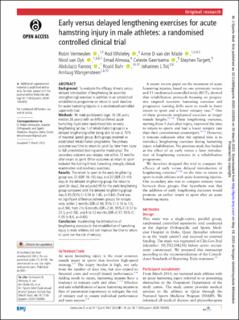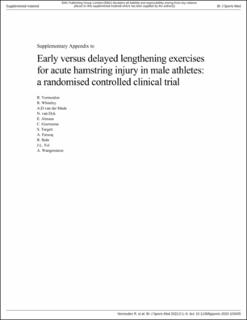| dc.contributor.author | Vermeulen, Robin | |
| dc.contributor.author | Whiteley, Rod | |
| dc.contributor.author | van der Made, Anne D. | |
| dc.contributor.author | van Dyk, Nicol | |
| dc.contributor.author | Almusa, Emad | |
| dc.contributor.author | Geertsema, Celeste | |
| dc.contributor.author | Targett, Stephen | |
| dc.contributor.author | Farooq, Abdulaziz | |
| dc.contributor.author | Bahr, Roald | |
| dc.contributor.author | Tol, Johannes L. | |
| dc.contributor.author | Wangensteen, Arnlaug | |
| dc.date.accessioned | 2022-05-27T13:23:47Z | |
| dc.date.available | 2022-05-27T13:23:47Z | |
| dc.date.created | 2022-04-12T16:22:09Z | |
| dc.date.issued | 2022 | |
| dc.identifier.citation | British Journal of Sports Medicine. 2022, Artikkel 103405. | en_US |
| dc.identifier.issn | 0306-3674 | |
| dc.identifier.uri | https://hdl.handle.net/11250/2996518 | |
| dc.description | This is an open access article distributed in accordance with the Creative Commons Attribution Non Commercial (CC BY-NC 4.0) license, which permits others to distribute, remix, adapt, build upon this work non-commercially, and license their derivative works on different terms, provided the original work is properly cited, appropriate credit is given, any changes made indicated, and the use is non-commercial. | en_US |
| dc.description.abstract | Background: To evaluate the efficacy of early versus delayed introduction of lengthening (ie, eccentric strengthening) exercises in addition to an established rehabilitation programme on return to sport duration for acute hamstring injuries in a randomised controlled superiority trial.
Methods: 90 male participants (age: 18–36 years, median 26 years) with an MRI-confirmed acute hamstring injury were randomised into an early lengthening (at day 1 of rehabilitation) group or a delayed lengthening (after being able to run at 70% of maximal speed) group. Both groups received an established rehabilitation programme. The primary outcome was time to return to sport (ie, time from injury to full unrestricted training and/or match play). The secondary outcome was reinjury rate within 12 months after return to sport. Other outcomes at return to sport included the Askling H-test, hamstring strength, clinical examination and readiness questions.
Results: The return to sport in the early lengthening group was 23 (IQR 16–35) days and 33 (IQR 23–40) days in the delayed lengthening group. For return to sport (in days), the adjusted HR for the early lengthening group compared with the delayed lengthening group was 0.95 (95% CI 0.56 to 1.60, p=0.84). There was no significant difference between groups for reinjury rates within 2 months (OR=0.94, 95% CI 0.18 to 5.0, p=0.94), from 2 to 6 months (OR=2.00, 95% CI 0.17 to 23.3, p=0.58), and 6 to 12 months (OR=0.57, 95% CI 0.05 to 6.6, p=0.66).
Conclusion: Accelerating the introduction of lengthening exercises in the rehabilitation of hamstring injury in male athletes did not improve the time to return to sport nor the risk of reinjury. | en_US |
| dc.language.iso | eng | en_US |
| dc.subject | exercise therapy | en_US |
| dc.subject | hamstring muscles | en_US |
| dc.subject | randomized controlled trial | en_US |
| dc.subject | rehabilitation | en_US |
| dc.subject | wounds and Injuries | en_US |
| dc.title | Early versus delayed lengthening exercises for acute hamstring injury in male athletes: A randomised controlled clinical trial | en_US |
| dc.type | Peer reviewed | en_US |
| dc.type | Journal article | en_US |
| dc.description.version | publishedVersion | en_US |
| dc.rights.holder | © Author(s) (or their employer(s)) 2022 | en_US |
| dc.source.pagenumber | 9 | en_US |
| dc.source.journal | British Journal of Sports Medicine | en_US |
| dc.identifier.doi | 10.1136/bjsports-2020-103405 | |
| dc.identifier.cristin | 2017079 | |
| dc.description.localcode | Institutt for idrettsmedisinske fag / Department of Sports Medicine | en_US |
| dc.source.articlenumber | 103405 | en_US |
| cristin.ispublished | true | |
| cristin.fulltext | original | |
| cristin.qualitycode | 2 | |

